CONTENTS
Back-to-Back 20-run Games
The War Took Its Toll
HOF Managers Who Never Played MLB
One HR at Home Entire Season
Catch Ball from Washington Monument
Browns to L.A.
Pitch 100 Games with 1,500 Hits
Baseball Players by Country
Yellow Baseballs
Juiced Balls?
Baseball
Did You Know – I
Baseball
Did You Know – III
Baseball
Did You Know – IV
Baseball
Did You Know – V
Baseball
Did You Know – VI
Baseball
Did You Know – VII
Baseball Page
Golden Rankings Home |
Baseball
Did You Know? – II
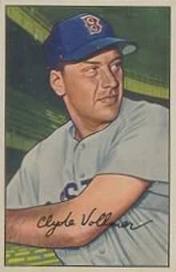
Clyde Vollmer
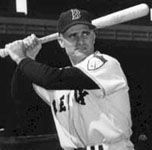
Bobby Doerr
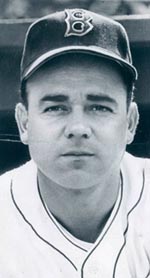
Al Zarilla

Sid Schacht
|
Back-to-Back 20-run Games
On June 7, 1950, the Boston Red Sox defeated the visiting St. Louis Browns 20-4. The next day the Bosox enjoyed a 29-4 rout against the same opponent.
- In the first game, the Sox pelted three Browns pitchers for 23 hits. All 20 runs were earned.
- Six of the first seven batters in the potent Boston lineup had at least three hits each.
- CF Clyde Vollmer 3-for-5 with 2 HR, 5 RBI, and 3 runs
- 3B Johnny Pesky 4-for-6 with 0 RBI and 3 runs
- LF Ted Williams 3-for-5 with 3 RBI and 2 runs
- SS Vern Stephens 4-for-6 with 2 HR, 5 RBI, and 3 runs
- RF Al Zarilla 3-for-4 with 1 RBI and 3 runs
- 2B Bobby Doerr 3-for-5 with 1 RBI and 1 run
- Only P Joe Dobson failed to get a hit (0-for-5).
- Through that game, the immortal Williams had merely the sixth best average on the team, .333. Vollmer led with .383, 1B Walt Dropo .372, Zarilla .358, Pesky .343, and C Birdie Tebbetts .339.
The next day, the Red Sox did themselves 9 better.
- They belted 28 hits, including 7 HRs. Three of the 29 runs were unearned.
- Doerr led the onslaught with 8 RBIs on a single and 3 HRs in 6 ABs.
- Pesky had 5 hits in 7 ABs.
- Dropo batted in 7 on 4-for-6, including 2 HR.
- Ted was "only" 2-for-5, both HRs, but drove in 5.
- RHP Sid Schacht bore the brunt of the Boston attack. His line read 13 H, 12 R (9 ER) in 3 2/3 innings.
- Another righty, Clarence "Cuddles" Marshall gve up 9 runs in 1 2/3.
- Red Sox manager Joe McCarthy did not make a single substitution in either blowout.
The Red Sox completed the season 94-60, good for third place behind the Yankees and Tigers.
- They led the AL in batting with a .302 average, 20 points better than the two teams that finished ahead of them in the standings.
- Boston plated 1,027 runs, the fourth highest total in baseball history and 113 more than the Yankees, their nearest competitor.
- The Red Sox scored 15 or more runs six times and had another game with over 20 runs, a 22-14 victory at Philadelphia June 29.
- McCarthy's pitching staff compiled a 4.88 ERA for the season, which was sixth in the eight-team league. As you might imagine, the Browns were one of the two staffs with a higher ERA, although St. Louis did pitch better than the Philadelphia Athletics.
|
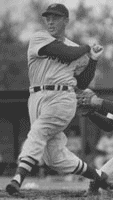
Vern Stephens

Johnny Pesky
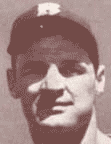
Walt Dropo

"Cuddles" Marshall
|
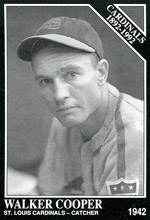

Marty Marion

Whitey Kurowski
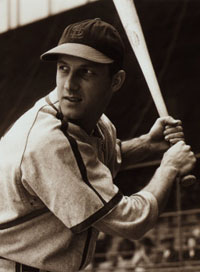
Stan Musial
|
For only the sixth time in the 40 World Series played to that point, the St. Louis Cardinals met the New York Yankees for the second straight year in the Fall Classic of 1943.
The contrast in the starting lineups of the two teams illustrated the effects of World War II on baseball.
St. Louis Cardinals
1942 Starters (106-48) |
|
1943 Starters (105-49) |
Player |
Avg./
Record |
Position |
Avg./
Record |
Player |
Walker Cooper |
.281 |
C |
.318 |
Walker Cooper |
Johnny Hopp |
.258 |
1B |
.280 |
Ray Sanders |
Jimmy Brown |
.256 |
2B |
.287 |
Lou Klein* |
Marty Marion |
.276 |
SS |
.280 |
Marty Marion |
Whitey Kurowski |
.254 |
3B |
.287 |
Whitey Kurowski |
Stan Musial |
.315 |
LF |
.275 |
Danny Litwhiler |
Terry Moore |
.288 |
CF |
.294 |
Harry Walker* |
Enos Slaughter |
.318 |
RF |
.357 |
Stan Musial |
Mort Cooper |
22-7 |
P |
21-8 |
Mort Cooper |
Johnny Beazley |
21-6 |
P |
15-7 |
Max Lanier |
Max Lanier |
13-8 |
P |
10-5 |
Harry Gumbert* |
The names in red in 1942 were no longer with the club the next year, being replaced by the red names in the '43 column. * in the '43 column indicates the player was not on the Cardinals '44 World Champions. So in the two years from '42 to '44, the club lost six starting fielders and two frontline P. (Hopp was lost to injury, not military service.)
New York Yankees
1942 Starters (103-51) |
|
1943 Starters (98-56) |
Player |
Avg./
Record |
Position |
Avg./
Record |
Player |
Bill Dickey |
.295 |
C |
.351 |
Bill Dickey |
*Buddy Hassett |
.284 |
1B |
.271 |
Nick Etten |
Joe Gordon |
.322 |
2B |
.249 |
Joe Gordon |
Phil Rizzuto |
.284 |
SS |
.233 |
Frankie Crosetti |
*Frankie Crosetti |
.242 |
3B |
.280 |
Billy Johnson |
Charlie Keller |
.292 |
LF |
.271 |
Charlie Keller |
Joe DiMaggio |
.305 |
CF |
.245 |
Johnny Lindell |
Tommy Henrich |
.267 |
RF |
.261 |
Bud Metheny |
*Tiny Bonham |
21-5 |
P |
20-4 |
Spud Chandler |
Spud Chandler |
16-5 |
P |
15-8 |
Tiny Bonham |
*Hank Borowy |
15-4 |
P |
14-9 |
Hank Borowy |
The * next to names in the '42 column indicates the player was not a starter on the Yankees 1941 World Champs. So over the two seasons from '41 to '43, the club lost five position starters and two front-line P.
Other comments about the transition from '42 to '43:
- Each team had a 50% turnover among the eight position players.
- Obviously the biggest loss for either side was DiMaggio. His replacement, Lindell, had been a P the year before!
- For the Cardinals the biggest loss was Beazley who had a sensational rookie season in '42, including two victories in the Series. Johnny hurt his arm pitching in the service and won only 9 more games when he returned to the majors.
The results of the Series flipped around.
- The Cards won in '42 four games to one.
- The Yanks copped the '43 Classic by the same tally.
By Opening Day of '44, the Yankees lost Dickey, Gordon, Johnson, Keller, and Chandler to the service. They sank to third as the lowly St. Louis Browns capitalized on the depleted talent pool to win their only pennant in franchise history.
The Cardinals played the '45 season without the Cooper brothers, Musial, Litwhiler, and Lanier. So their reign of three straight NL pennants ended as the Cubs captured what to this day remains their last Senior Circuit crown.
|

Bill Dickey
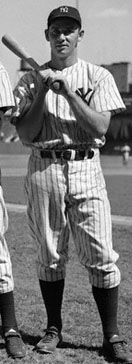
Joe Gordon
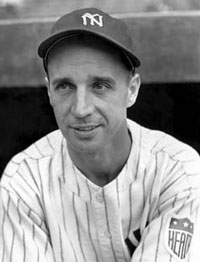
Frankie Crosetti
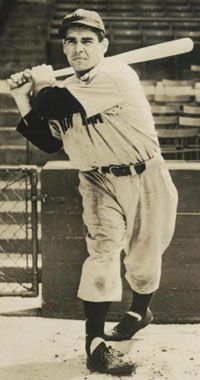
Charlie Keller
Top of Page
|
HOF Managers Who Never Played MLB
Two
Hall of Fame managers never played a single game in the major leagues:
Joe
McCarthy and Earl
Weaver.
- McCarthy
retired in 1950 with a lifetime .614 winning percentage (which was
the all-time best at the time) with the Cubs
(1926-30), Yankees (1931-1946),
and Red Sox (1948-1950).
He won pennants with Chicago
in 1929 and New York in
1932, 1936-9, and 1941-3. He won the World Series in 1932, 1936-9,
1941, and 1943. His teams also finished second seven times (notably
Boston in 1948 and
1949). He never finished out of the first division.
- Weaver's
entire ML managerial career was spent with the Baltimore
Orioles (1968-82 and 1985-6). His teams won four pennants
(1969-71, 1979) and one World Series (1970). His winning percentage
is .583. Unfortunately, Earl is better known for
being ejected from more games than any manager in AL history –
97. (Bobby Cox now holds the ML mark.) Earl
played for the New Orleans Pelicans
before beginning his minor league managerial career in 1957.
|
One HR at Home Entire Season
On
September 7, 1945, the Washington Senators
defeated the St. Louis Browns
3-2 to stay 1.5 games behind the league-leading Detroit
Tigers. George Case stole home for
one Washington run. But
even more remarkable was that the Senators
Joe Kuhel hit an inside-the-park HR. Why was this so
remarkable? It was the only HR the Senators
hit in their home park, Griffith
Stadium, all season. The park boasted these dimensions: 407'
down the left field line, 421 to center, and 328 down the right field
line but with a tall wall. Visiting teams hit a grand total of six HRs
that season. The Senators,
who finished one game behind the Tigers,
ended the season with only 27 four-baggers. (This was not last in the
league. That honor went to the White Sox
with their 22 round-trippers.) 3B Harlond Clift led
the team with 8 four-baggers. (In evaluating these woeful HR numbers,
remember that 1945 was the last season before servicemen returned en
masse to baseball.)
Another
interesting feature of the Senator
win is that it shared the sports page in the next day's Washington
Post with two other news items.
- Long-time
Senator hero Cecil
Travis, recently discharged from the service, would return
to his SS position. Unfortunately, Travis had suffered
frostbite during the Battle of the Bulge and could not perform anywhere
near his pre-service level. He retired in 1947. His WWII service probably
cost him induction into the HOF.
- Nearby
University
of Maryland hired Lt. Cdr. Paul Bryant
to coach its football team.
|
Catch Ball from Washington Monument
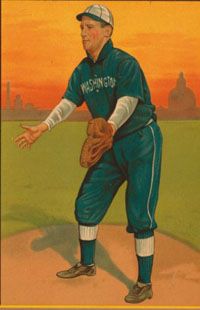
Gabby Street |
The
New York Times reported on August 22, 1908, that, the day before, Washington Nationals catcher Charles
"Gabby" Street, to win a $500 bet, caught a baseball
dropped from the observation window in the Washington Monument, 550'
above the ground. According to the article, many catchers, including Paul Hines, Charley Snyder, and Buck
Ewing, had tried in previous years but failed. It was estimated
that the ball was traveling 140 feet per second when Street caught it on the thirteenth try. Most of the previous times, the breeze
carried the ball too far from him. The dangerous experiment had received
a permit from Col. Bromwell, Superintendent of Public
Buildings and Grounds. For
the successful catch, Street broke the force of the
ball by raising his arms and then easing down gradually. Still, the
ball striking his mitt made a sound that could be heard hundreds of
yards away. Gabby held the horsehide long enough to
win the bet before rubbing his sore hands. He was able to catch Walter
Johnson's 3-1 victory that afternoon over the Detroit
Tigers. The article does not reveal who the bettor was. Street later managed the 1930 and 1931 Cardinals to the World Series, winning one. |
The
Times was unaware that 14 years earlier, August 24, 1894, Pop
Shriver of the Chicago White
Sox had caught a ball dropped from that same monument
window. The person who dropped the ball was Shriver's
teammate Clark Griffith. (Later the manager/owner of
the Nationals, Clark
managed the New York Highlanders
in 1908 and therefore was not Street's accomplice.)
Similar
stunts occurred in subsequent years.
- In
1914 Brooklyn C Wilbert
Robinson was persuaded to try to catch a ball dropped from
an airplane flying over the Dodgers'
spring training camp. However, the pilot, Ruth Law,
forgot to take a baseball aboard the flight. So she substituted a
grapefruit! Robinson nevertheless caught the larger
spheroid, despite being knocked down by the force.
- On
April 1, 1930, the Cubs
were in Los Angeles to play their Angels farm club.
Before the game, a ball was dropped from a blimp flying over the field
at an altitude of 800'. Future Hall of Fame C Gabby Hartnett
caught that ball as well as a second one dropped shortly after the
first. Gabby's feat still stands as the record for
catching a ball dropped from the greatest height.
|
The
St. Louis Browns were all set to move to Los Angeles
for the 1942 season. Who could blame them for wanting to relocate?
- While
the St. Louis Cardinals
drew over 600,000 fans in 1941, the Browns barely
drew 175,000. It was clear that St. Louis could not support two
teams.
- The
Los Angeles Chamber of Commerce guaranteed attendance of 500,000,
a figure the Browns had not achieved since 1924.
(In 1933, during the Great Depression, the club drew just 88,113
fans for the entire year. One game that season attracted just 34
paying customers.)
- The
Browns would play in Wrigley
Field, the stadium of the Pacific Coast League's Los
Angeles Angels. As part of the agreement to move
to Los Angeles, the Browns would buy the stadium.
The
Major League Baseball owners were expected to approve the move at their
Winter Meetings in Chicago on December 8. However, President
Roosevelt declared war against Japan that very day after the
Pearl Harbor attack the previous day. Because of the uncertainty created
by the U.S.'s entry into World War II, the Browns'
move was postponed.
The
Sporting News, known as "The Bible of Baseball,"
wrote this in its December 18, 1941 issue:
Donald
Barnes, president of the St. Louis Browns,
may have been several years ahead of the times in his proposal that
the franchise be moved to Los Angeles, but many in the majors will
live to see the day when his idea ... will become a reality. Eventually,
one of the major leagues is almost certain to include the California
metropolis in its membership.
By
the time the war ends, the airplane will be developed to such an extent
that transporting an entire club from other major league cities by
air will present no more of a problem than moving them by trains does
today. ... The shift will not come next year, or, very likely, the
year after. However, it can be put down in the future book that Los
Angeles will be in the big leagues within less than a decade ...
The
editor was off by seven years in his estimate – the Dodgers
and Giants didn't move
to the West Coast until 1958. However, his prediction is amazingly prescient.
Stuck
in St. Louis, the Browns won their only AL pennant
in 1944, thanks in part to the diluted talent pool created by the War.
They were defeated by their Sportsman Park tenants, the Cardinals,
in six games in the World Series. The franchise was eventually moved
to Baltimore after the 1953 season.
|
Pitch 100 Games with 1,500 Hits
Only
two players in MLB history have pitched more than 100 games and collected
more than 1,500 hits. One, obviously, is Babe Ruth.
The other, not so obviously, is Cy Seymour.
Cy
(short for "Cylcone," the nickname given
him by NY sportswriters) played for the New
York Giants (1896-1900 and 1906-1910), Baltimore
Orioles (1901-2), Cincinnati
Reds (1902-06), and Boston
Braves (1913). (The Orioles
were a charter franchise of the American League before being replaced
by the New York Hilltoppers
in 1903.) Cy pitched for the Giants
at the beginning of his career, compiling a record of 61-56 over
five seasons. The lefty won 25 games in 1898 with an ERA of 3.18
for a seventh-place team. He also led the NL in strikeouts-per-nine-innings
in three successive seasons (1897-1899). He threw a fastball, what
some called the best curve in the league, and a screwball. However,
he had a reputation as a "balloonist" or "aerialist"
because he suddenly got excited and wild during games. He led the
NL in walks from 1897-9. He played a few games in the OF during
these years but, after he hit .327 in 1899 and .300 in 1900, there
was serious discussion about moving him full-time to the OF. Also
three consecutive years of 268+ innings took its toll on his arm.
He threw only 53 innings in 1900.
|

Cy Seymour |
When
he jumped to Baltimore
of the new American League in 1901 to get away from the Giants
tyrannical owner Andrew Freedman, Seymour
became a full-time OF for the rest of his career. His finest season
was 1905 when he led the NL in batting average (.377), hits (219), total
bases (325), slugging % (.559), on-base percentage (retroactively calculated
as .988), doubles (40), triples (21), and RBI (121). For
his career, he batted .303 with 1723 hits, 799 RBI, and 52 HR.
|
Baseball Players by Country
Here
is the breakdown of professional baseball players in the United States
by country of origin (as of May 2007).
- United
States 57.0%
- Dominican
Republic 21.4%
- Venezuela
11.8%
- Puerto
Rico 2.0%
- Mexico
1.4%
- Canada
1.3%
- Others
5.1%
|
The
white baseball is as American as apple pie and has stood the test of
time. However, in 1938 Larry MacPhail, general manager
of the Brooklyn Dodgers,
suggested yellow baseballs which were actually used on August 2 in a
game at Ebbets Field. The Dodgers
defeated the St. Louis Cardinals
6-2 in the first game of a doubleheader. The teams reverted to white
balls in the nightcap which Brooklyn
also won, 9-3.
In
1939, the yellow ball was used in three more Dodger
games. The Cardinals were
again the opposition in two of them, winning 12-0 on July 23 at Ebbets
Field (again in the first game of a Sunday DH with the second game played
with white balls) and 5-2 July 31 at Sportsman's Park. The Bums
defeated the Chicago Cubs
10-4 in the other game on September 14 at Wrigley Field (same MO, first
game of DH). After that, the ball was never used again.
Fast
forward to 1973. Charley Finley, owner of the
Oakland A's, experimented with an orange baseball
during spring training, claiming hitters could see it better. An orange
ball was also used at the Houston Astrodome when it first opened to
see if it reduced the glare of the lights. The orange ball never made
it into a regular season game in either league.
|
We
know that many of the players have been juiced. But what about the baseballs
themselves?
An
article
in Wired magazine reveals some of the behind-the-scenes
testing that goes on at the Baseball Research Center at the University
of Massachusetts-Lowell. Twice a year since 2000, Professor
James Sherwood and his cohorts certify the balls used
in Major League games. At the start of each season and again just before
the start of the World Series, Rawlings sends 72-to-96 balls from their
warehouse. Sherwood's team weighs and measures each
spheroid. They also fire two dozen balls at a slab of ash (the wood
used in most bats) to record the rebound speed.
Although
most pitchers can hurl the horsehide at 90 mph, MLB decrees that
the baseballs to be tested must be propelled at only 58 mph and
rebound within a range that was set decades ago. Frustrated by the restrictions,
Sherwood says 58 mph is not fast enough to accurately
determine a ball's liveliness. "Their testing window is too big.
I don't know why it was ever set that wide. A ball testing at the high
end could travel as much as 50 feet father than one falling on the low
end." 50 feet, of course, would make a big difference in the number
of home runs.
The
Center has machines and instruments that could bring the testing procedures
into the 21st century. But MLB doesn't like change. Sherwood
estimates that MLB hasn't changed the ball design since Babe
Ruth played.
The
Center runs additional tests on the balls using more modern equipment
and may someday present the findings to MLB. "Maybe they'll change
their minds." The author of the article concludes, "Sure they
will. Right after the
Cubs win
the World Series."
|
|